EC 320, Spring 2020 Homework: Land, Health, and Gender Economics
VerifiedAdded on 2022/09/25
|15
|1739
|18
Homework Assignment
AI Summary
This economics homework assignment from EC 320 addresses key issues in less-developed regions. It begins with an analysis of land tenure arrangements, specifically sharecropping and fixed rent contracts, examining their impact on farmer incentives and risk aversion under varying rainfall conditions. The assignment then shifts to health and nutrition, exploring mortality trends, including infant, child, and maternal mortality rates, with data from the USA. The discussion extends to family and gender dynamics, analyzing concepts like "missing women," gender discrimination, and barriers to improving education. The solution explores research methodologies, including random sampling and natural experiments, and outlines approaches to address gender stereotyping and educational challenges. The assignment concludes by examining barriers to improving education through response surface, partial factorial, and factorial designs, and emphasizes the importance of baseline surveys for comprehensive analysis.

Paraphrase This Document
Need a fresh take? Get an instant paraphrase of this document with our AI Paraphraser
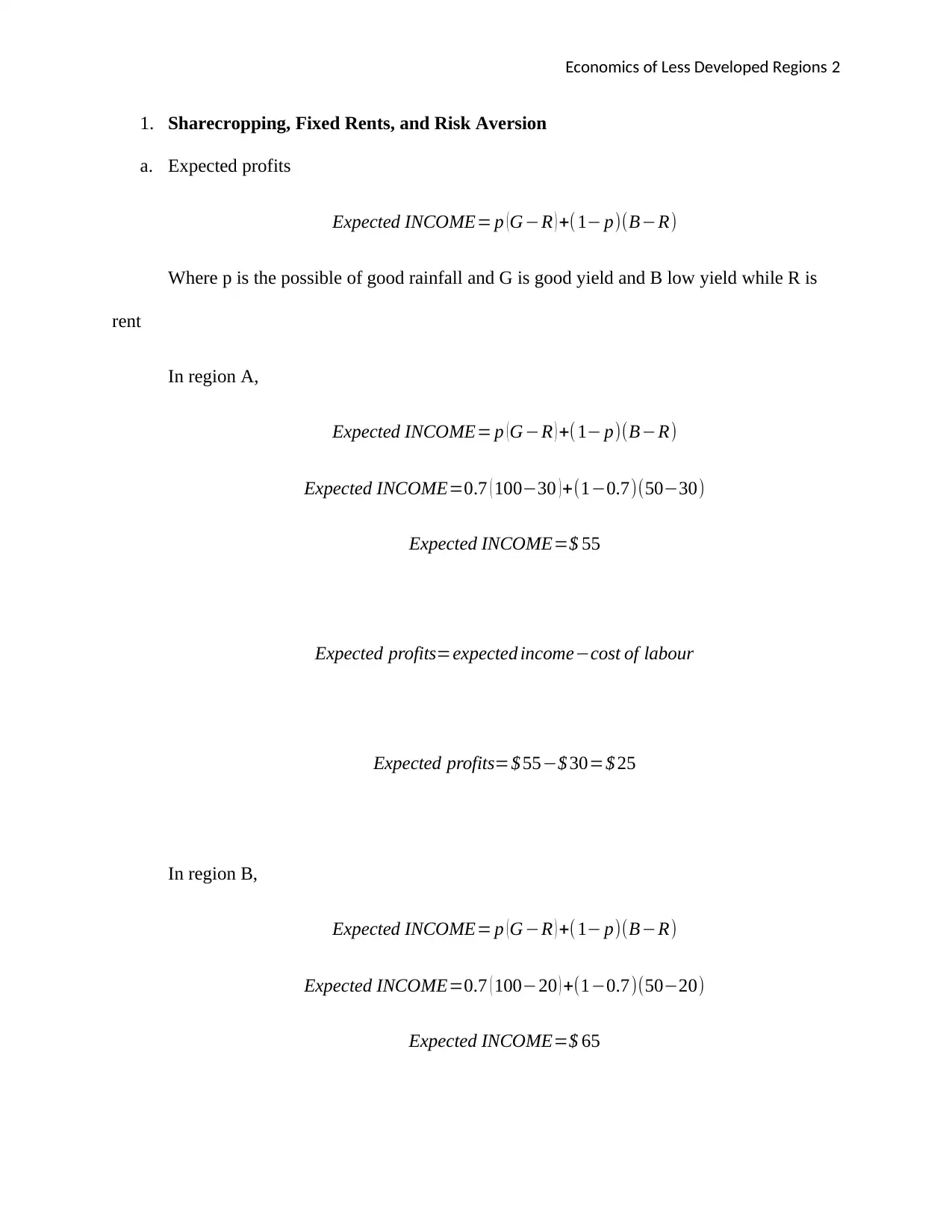
Economics of Less Developed Regions 2
1. Sharecropping, Fixed Rents, and Risk Aversion
a. Expected profits
Expected INCOME= p ( G−R ) +( 1− p)(B−R)
Where p is the possible of good rainfall and G is good yield and B low yield while R is
rent
In region A,
Expected INCOME= p ( G−R ) +( 1− p)(B−R)
Expected INCOME=0.7 ( 100−30 ) +(1−0.7)(50−30)
Expected INCOME=$ 55
Expected profits=expected income−cost of labour
Expected profits=$ 55−$ 30=$ 25
In region B,
Expected INCOME= p ( G−R ) +( 1− p)(B−R)
Expected INCOME=0.7 ( 100−20 ) +(1−0.7)(50−20)
Expected INCOME=$ 65
1. Sharecropping, Fixed Rents, and Risk Aversion
a. Expected profits
Expected INCOME= p ( G−R ) +( 1− p)(B−R)
Where p is the possible of good rainfall and G is good yield and B low yield while R is
rent
In region A,
Expected INCOME= p ( G−R ) +( 1− p)(B−R)
Expected INCOME=0.7 ( 100−30 ) +(1−0.7)(50−30)
Expected INCOME=$ 55
Expected profits=expected income−cost of labour
Expected profits=$ 55−$ 30=$ 25
In region B,
Expected INCOME= p ( G−R ) +( 1− p)(B−R)
Expected INCOME=0.7 ( 100−20 ) +(1−0.7)(50−20)
Expected INCOME=$ 65
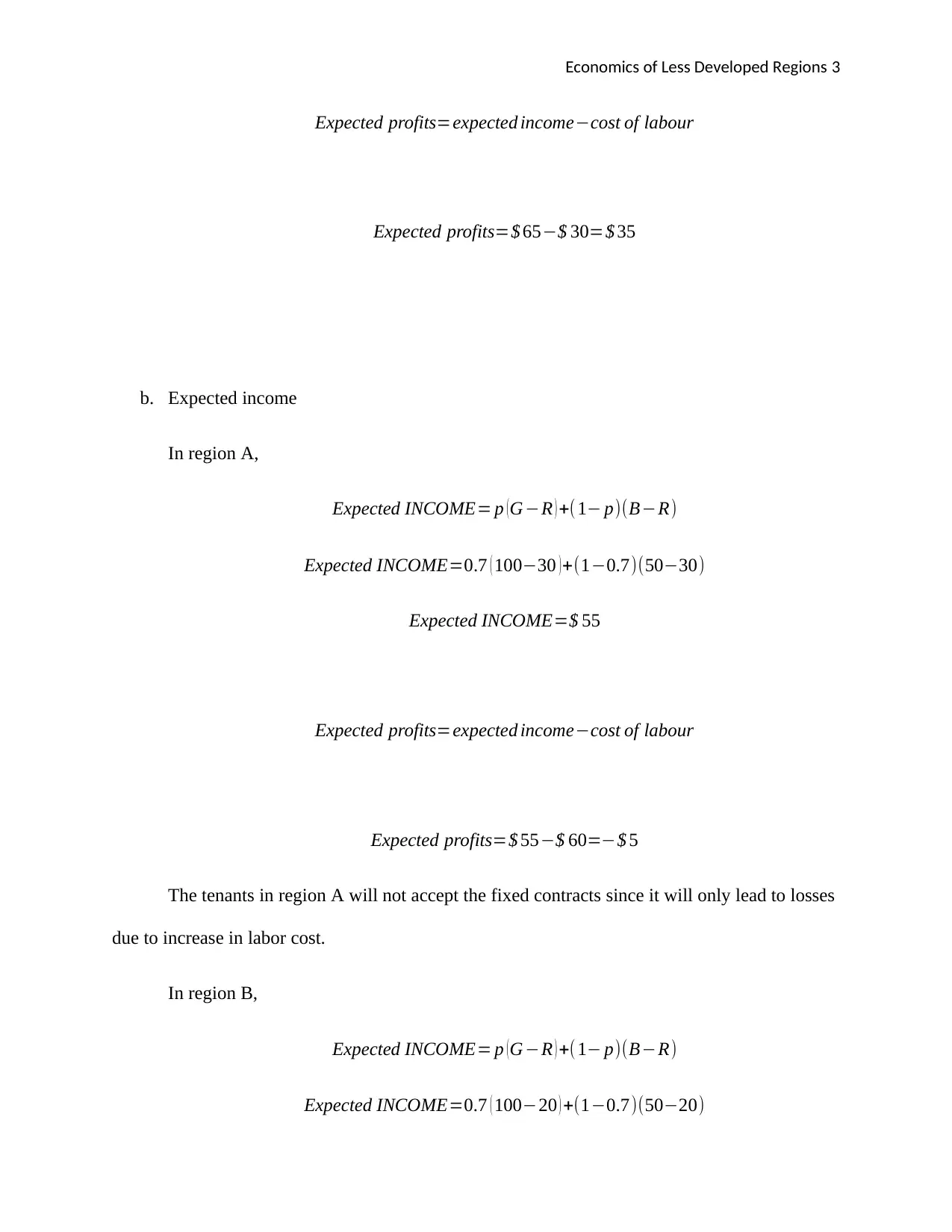
Economics of Less Developed Regions 3
Expected profits=expected income−cost of labour
Expected profits=$ 65−$ 30=$ 35
b. Expected income
In region A,
Expected INCOME= p ( G−R ) +( 1− p)(B−R)
Expected INCOME=0.7 ( 100−30 ) +(1−0.7)(50−30)
Expected INCOME=$ 55
Expected profits=expected income−cost of labour
Expected profits=$ 55−$ 60=−$ 5
The tenants in region A will not accept the fixed contracts since it will only lead to losses
due to increase in labor cost.
In region B,
Expected INCOME= p ( G−R ) +( 1− p)(B−R)
Expected INCOME=0.7 ( 100−20 ) +(1−0.7)(50−20)
Expected profits=expected income−cost of labour
Expected profits=$ 65−$ 30=$ 35
b. Expected income
In region A,
Expected INCOME= p ( G−R ) +( 1− p)(B−R)
Expected INCOME=0.7 ( 100−30 ) +(1−0.7)(50−30)
Expected INCOME=$ 55
Expected profits=expected income−cost of labour
Expected profits=$ 55−$ 60=−$ 5
The tenants in region A will not accept the fixed contracts since it will only lead to losses
due to increase in labor cost.
In region B,
Expected INCOME= p ( G−R ) +( 1− p)(B−R)
Expected INCOME=0.7 ( 100−20 ) +(1−0.7)(50−20)
⊘ This is a preview!⊘
Do you want full access?
Subscribe today to unlock all pages.

Trusted by 1+ million students worldwide
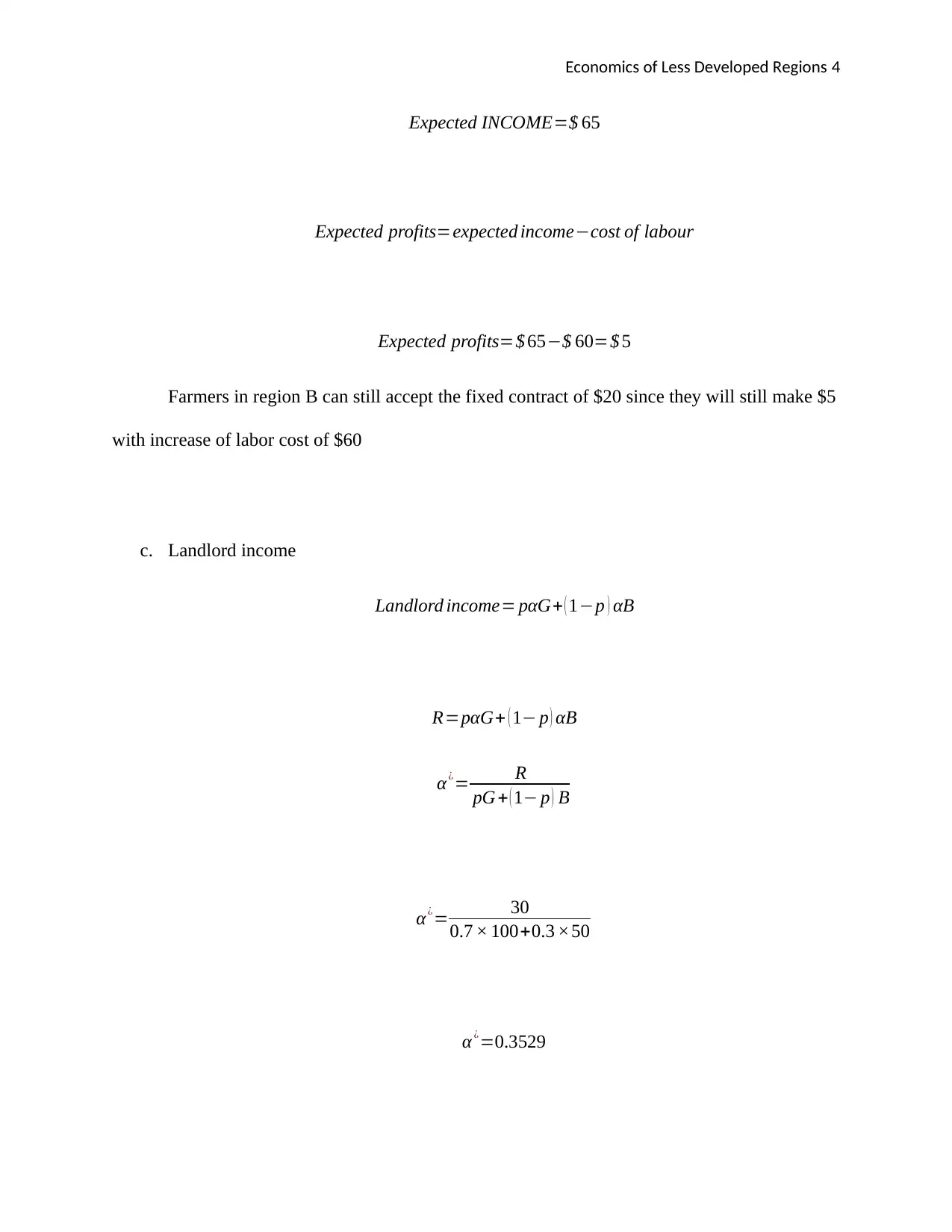
Economics of Less Developed Regions 4
Expected INCOME=$ 65
Expected profits=expected income−cost of labour
Expected profits=$ 65−$ 60=$ 5
Farmers in region B can still accept the fixed contract of $20 since they will still make $5
with increase of labor cost of $60
c. Landlord income
Landlord income= pαG+ ( 1−p ) αB
R=pαG+ ( 1− p ) αB
α ¿= R
pG + ( 1− p ) B
α¿= 30
0.7 × 100+0.3 ×50
α ¿=0.3529
Expected INCOME=$ 65
Expected profits=expected income−cost of labour
Expected profits=$ 65−$ 60=$ 5
Farmers in region B can still accept the fixed contract of $20 since they will still make $5
with increase of labor cost of $60
c. Landlord income
Landlord income= pαG+ ( 1−p ) αB
R=pαG+ ( 1− p ) αB
α ¿= R
pG + ( 1− p ) B
α¿= 30
0.7 × 100+0.3 ×50
α ¿=0.3529
Paraphrase This Document
Need a fresh take? Get an instant paraphrase of this document with our AI Paraphraser
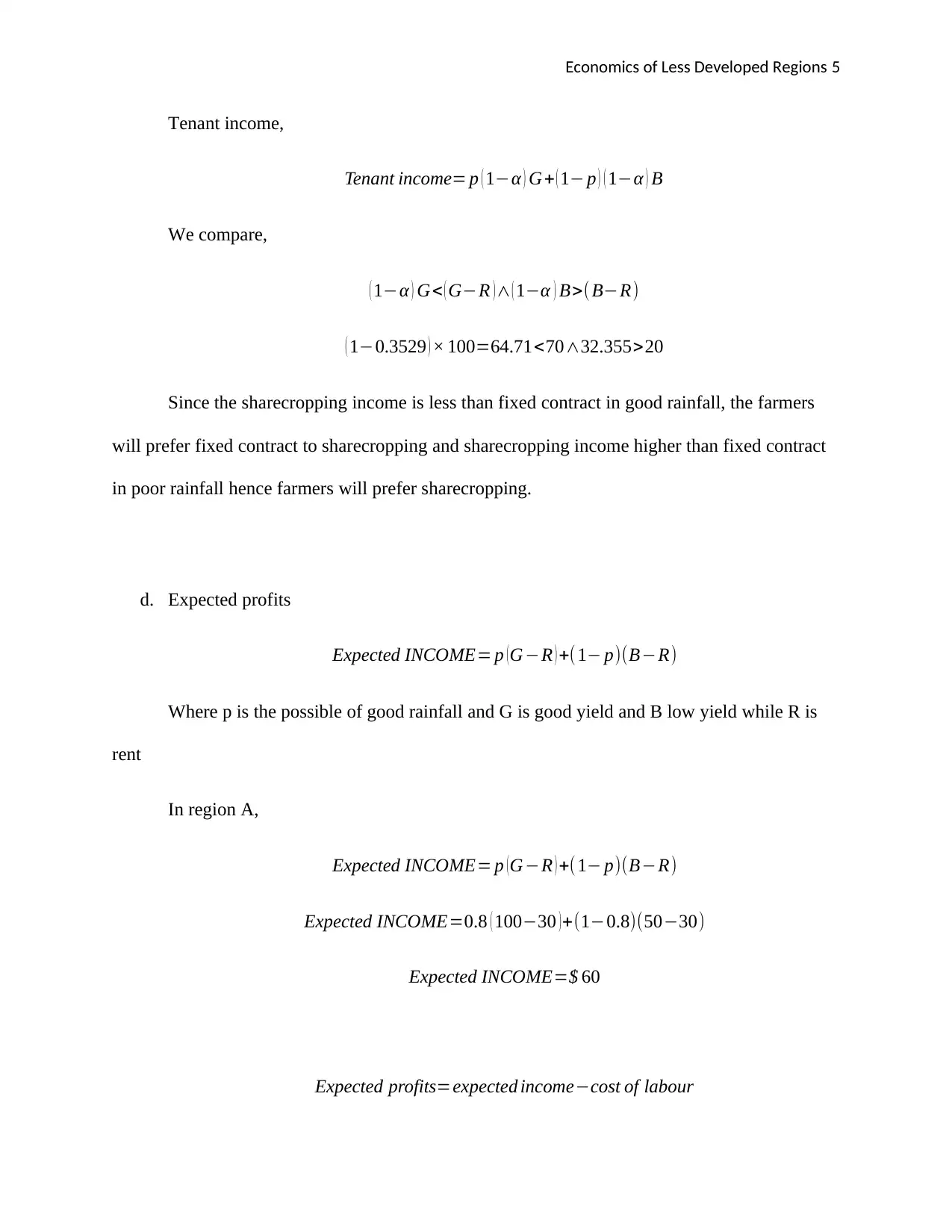
Economics of Less Developed Regions 5
Tenant income,
Tenant income= p ( 1−α ) G+ ( 1− p ) ( 1−α ) B
We compare,
( 1−α ) G< ( G−R )∧ ( 1−α ) B>( B−R)
( 1−0.3529 ) × 100=64.71<70∧32.355>20
Since the sharecropping income is less than fixed contract in good rainfall, the farmers
will prefer fixed contract to sharecropping and sharecropping income higher than fixed contract
in poor rainfall hence farmers will prefer sharecropping.
d. Expected profits
Expected INCOME= p ( G−R ) +( 1− p)(B−R)
Where p is the possible of good rainfall and G is good yield and B low yield while R is
rent
In region A,
Expected INCOME= p ( G−R ) +( 1− p)(B−R)
Expected INCOME=0.8 ( 100−30 ) +(1−0.8)(50−30)
Expected INCOME=$ 60
Expected profits=expected income−cost of labour
Tenant income,
Tenant income= p ( 1−α ) G+ ( 1− p ) ( 1−α ) B
We compare,
( 1−α ) G< ( G−R )∧ ( 1−α ) B>( B−R)
( 1−0.3529 ) × 100=64.71<70∧32.355>20
Since the sharecropping income is less than fixed contract in good rainfall, the farmers
will prefer fixed contract to sharecropping and sharecropping income higher than fixed contract
in poor rainfall hence farmers will prefer sharecropping.
d. Expected profits
Expected INCOME= p ( G−R ) +( 1− p)(B−R)
Where p is the possible of good rainfall and G is good yield and B low yield while R is
rent
In region A,
Expected INCOME= p ( G−R ) +( 1− p)(B−R)
Expected INCOME=0.8 ( 100−30 ) +(1−0.8)(50−30)
Expected INCOME=$ 60
Expected profits=expected income−cost of labour
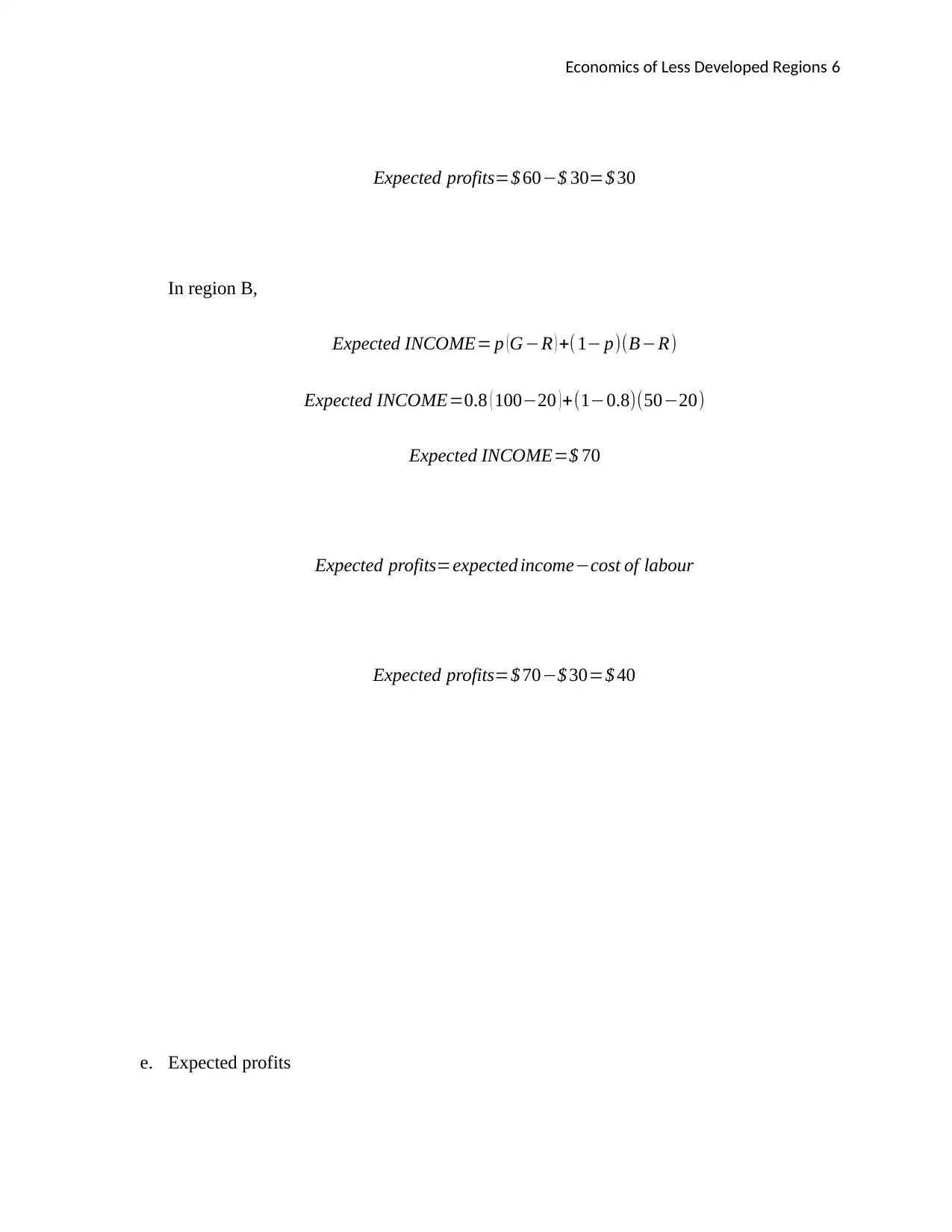
Economics of Less Developed Regions 6
Expected profits=$ 60−$ 30=$ 30
In region B,
Expected INCOME= p ( G−R ) +( 1− p)(B−R)
Expected INCOME=0.8 ( 100−20 ) +(1−0.8)(50−20)
Expected INCOME=$ 70
Expected profits=expected income−cost of labour
Expected profits=$ 70−$ 30=$ 40
e. Expected profits
Expected profits=$ 60−$ 30=$ 30
In region B,
Expected INCOME= p ( G−R ) +( 1− p)(B−R)
Expected INCOME=0.8 ( 100−20 ) +(1−0.8)(50−20)
Expected INCOME=$ 70
Expected profits=expected income−cost of labour
Expected profits=$ 70−$ 30=$ 40
e. Expected profits
⊘ This is a preview!⊘
Do you want full access?
Subscribe today to unlock all pages.

Trusted by 1+ million students worldwide
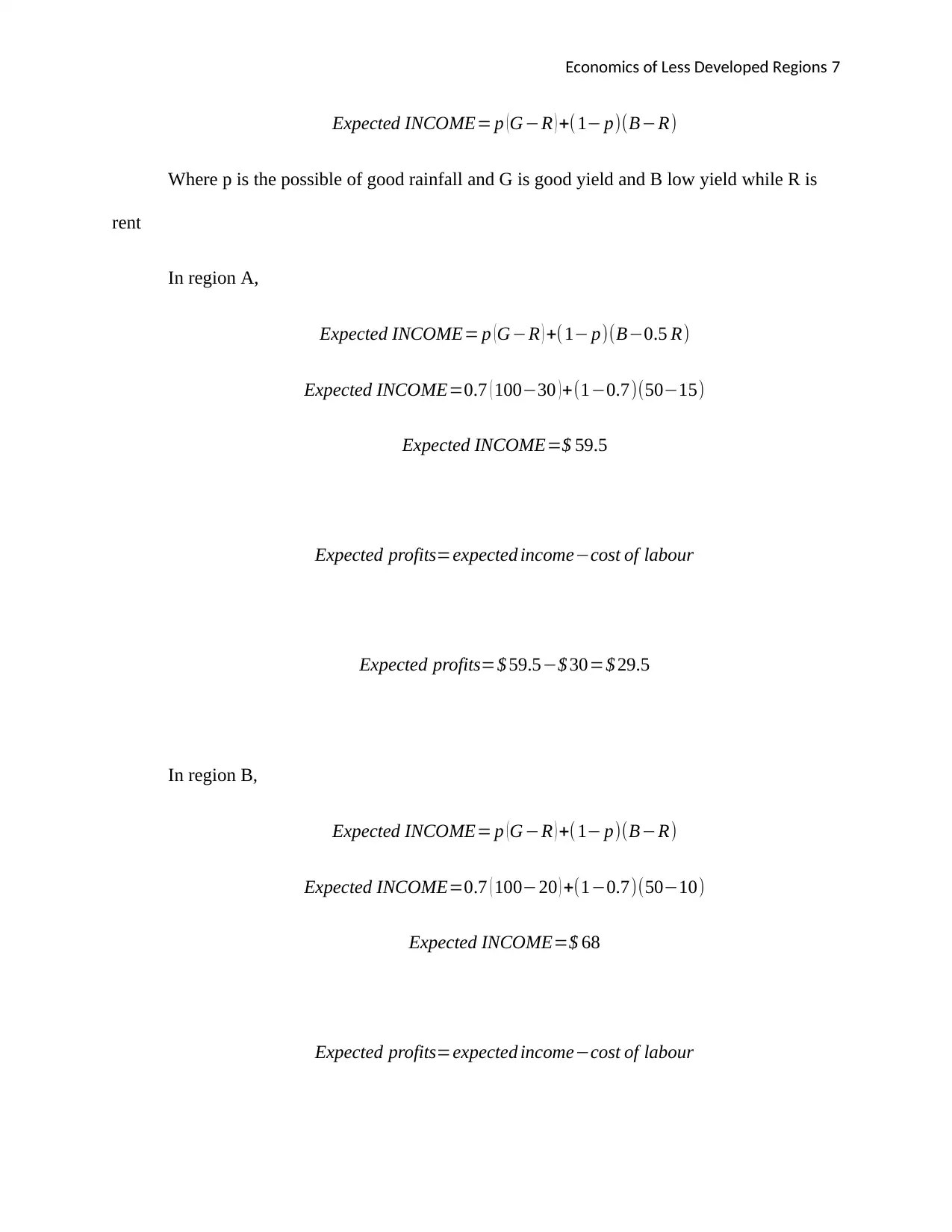
Economics of Less Developed Regions 7
Expected INCOME= p ( G−R ) +( 1− p)(B−R)
Where p is the possible of good rainfall and G is good yield and B low yield while R is
rent
In region A,
Expected INCOME= p ( G−R ) +(1− p)(B−0.5 R)
Expected INCOME=0.7 ( 100−30 ) +(1−0.7)(50−15)
Expected INCOME=$ 59.5
Expected profits=expected income−cost of labour
Expected profits=$ 59.5−$ 30=$ 29.5
In region B,
Expected INCOME= p ( G−R ) +( 1− p)(B−R)
Expected INCOME=0.7 ( 100−20 ) +(1−0.7)(50−10)
Expected INCOME=$ 68
Expected profits=expected income−cost of labour
Expected INCOME= p ( G−R ) +( 1− p)(B−R)
Where p is the possible of good rainfall and G is good yield and B low yield while R is
rent
In region A,
Expected INCOME= p ( G−R ) +(1− p)(B−0.5 R)
Expected INCOME=0.7 ( 100−30 ) +(1−0.7)(50−15)
Expected INCOME=$ 59.5
Expected profits=expected income−cost of labour
Expected profits=$ 59.5−$ 30=$ 29.5
In region B,
Expected INCOME= p ( G−R ) +( 1− p)(B−R)
Expected INCOME=0.7 ( 100−20 ) +(1−0.7)(50−10)
Expected INCOME=$ 68
Expected profits=expected income−cost of labour
Paraphrase This Document
Need a fresh take? Get an instant paraphrase of this document with our AI Paraphraser
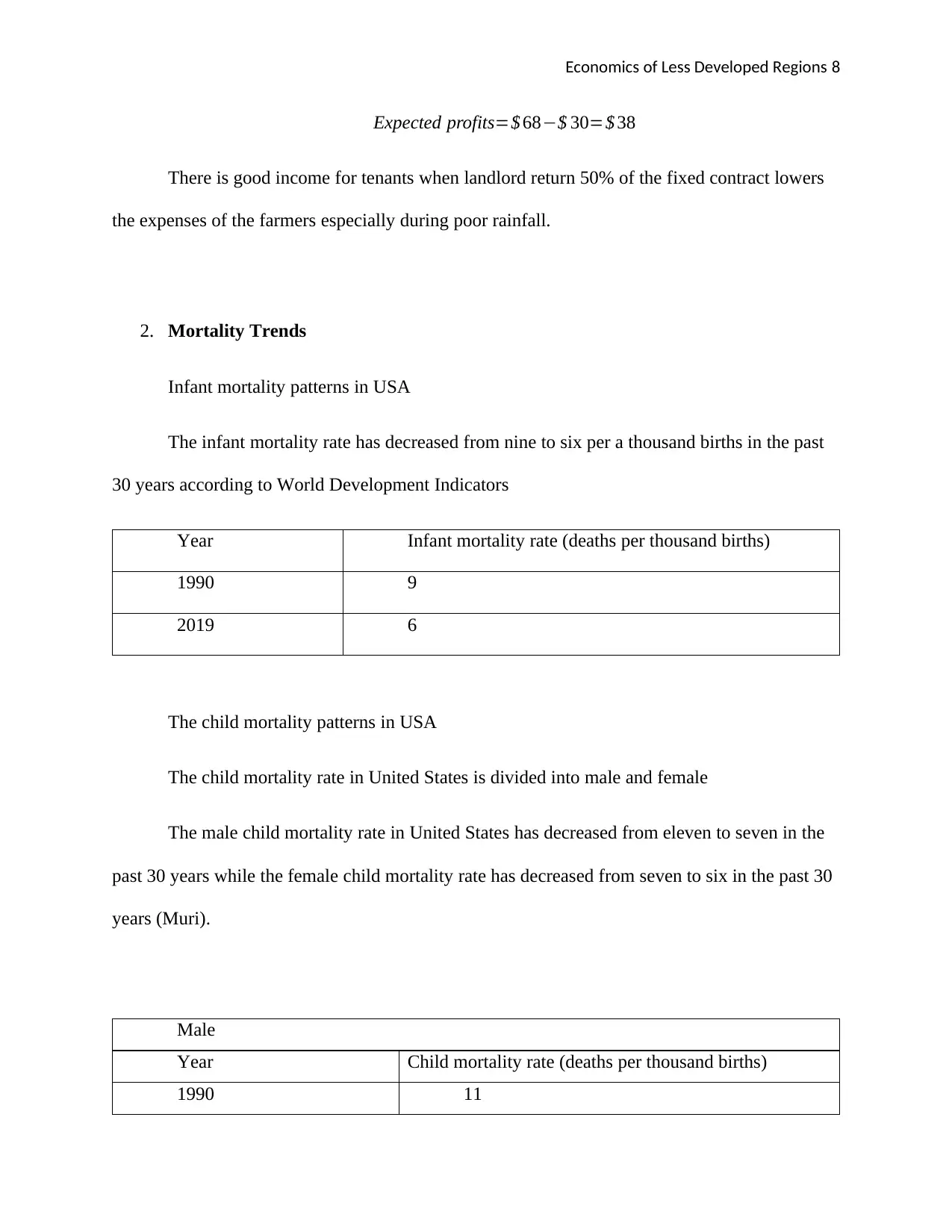
Economics of Less Developed Regions 8
Expected profits=$ 68−$ 30=$ 38
There is good income for tenants when landlord return 50% of the fixed contract lowers
the expenses of the farmers especially during poor rainfall.
2. Mortality Trends
Infant mortality patterns in USA
The infant mortality rate has decreased from nine to six per a thousand births in the past
30 years according to World Development Indicators
Year Infant mortality rate (deaths per thousand births)
1990 9
2019 6
The child mortality patterns in USA
The child mortality rate in United States is divided into male and female
The male child mortality rate in United States has decreased from eleven to seven in the
past 30 years while the female child mortality rate has decreased from seven to six in the past 30
years (Muri).
Male
Year Child mortality rate (deaths per thousand births)
1990 11
Expected profits=$ 68−$ 30=$ 38
There is good income for tenants when landlord return 50% of the fixed contract lowers
the expenses of the farmers especially during poor rainfall.
2. Mortality Trends
Infant mortality patterns in USA
The infant mortality rate has decreased from nine to six per a thousand births in the past
30 years according to World Development Indicators
Year Infant mortality rate (deaths per thousand births)
1990 9
2019 6
The child mortality patterns in USA
The child mortality rate in United States is divided into male and female
The male child mortality rate in United States has decreased from eleven to seven in the
past 30 years while the female child mortality rate has decreased from seven to six in the past 30
years (Muri).
Male
Year Child mortality rate (deaths per thousand births)
1990 11

Economics of Less Developed Regions 9
2019 7
Female
Year Child mortality rate (deaths per thousand births)
1990 7
2019 6
The maternal mortality patterns in USA
The maternal mortality rate in USA has been in increase from 10 to 24 maternal deaths
per 100000 in the past 30 years.
Female
Year Maternal mortality rate (deaths per hundred thousand births)
1990 7
2019 6
In the North America region, US has the reduced mortality rates in the past 30 years
compared to countries like Canada, Mexico
3. Family and Gender
a. “Missing women”
2019 7
Female
Year Child mortality rate (deaths per thousand births)
1990 7
2019 6
The maternal mortality patterns in USA
The maternal mortality rate in USA has been in increase from 10 to 24 maternal deaths
per 100000 in the past 30 years.
Female
Year Maternal mortality rate (deaths per hundred thousand births)
1990 7
2019 6
In the North America region, US has the reduced mortality rates in the past 30 years
compared to countries like Canada, Mexico
3. Family and Gender
a. “Missing women”
⊘ This is a preview!⊘
Do you want full access?
Subscribe today to unlock all pages.

Trusted by 1+ million students worldwide

Economics of Less Developed Regions 10
“Missing women” in the community is measured using sex ratios.
I will estimate the number males and females in the community by counting them then
divide the number of females by the number of males. This will give me the female to male ratio
hence “missing women” in the community (Putnam) (Ali).
b. Alternative explanation for gender discrimination
i. Sexual harassment and catching: harassment and catching of women and girls in the
streets has limited their freedom of walking freely. There are some authorities and
bystanders who have treated these harassment and catching normal which has
promoted discrimination in some communities.
ii. Stereotyping gender at work and school: stereotypes are the expectation of the
community on how gender should behave. For example, some communities expect
girls to stay at home and help with house chores and they should also dress in a
certain way. Staying out at night is also condemned by some communities. At school
girls discouraged not to participate in science and technology subjects.
iii. Objectification and poor presentation: when a person is treated as a commodity
without regarding their dignity and personality especially where women are
photoshopped and airbrushed to emphasize on their on their external appearance and
body. Girls are also poorly represented in the entertainment and media in ways that
promotes damaging gender stereotypes and traditional roles.
c.
“Missing women” in the community is measured using sex ratios.
I will estimate the number males and females in the community by counting them then
divide the number of females by the number of males. This will give me the female to male ratio
hence “missing women” in the community (Putnam) (Ali).
b. Alternative explanation for gender discrimination
i. Sexual harassment and catching: harassment and catching of women and girls in the
streets has limited their freedom of walking freely. There are some authorities and
bystanders who have treated these harassment and catching normal which has
promoted discrimination in some communities.
ii. Stereotyping gender at work and school: stereotypes are the expectation of the
community on how gender should behave. For example, some communities expect
girls to stay at home and help with house chores and they should also dress in a
certain way. Staying out at night is also condemned by some communities. At school
girls discouraged not to participate in science and technology subjects.
iii. Objectification and poor presentation: when a person is treated as a commodity
without regarding their dignity and personality especially where women are
photoshopped and airbrushed to emphasize on their on their external appearance and
body. Girls are also poorly represented in the entertainment and media in ways that
promotes damaging gender stereotypes and traditional roles.
c.
Paraphrase This Document
Need a fresh take? Get an instant paraphrase of this document with our AI Paraphraser
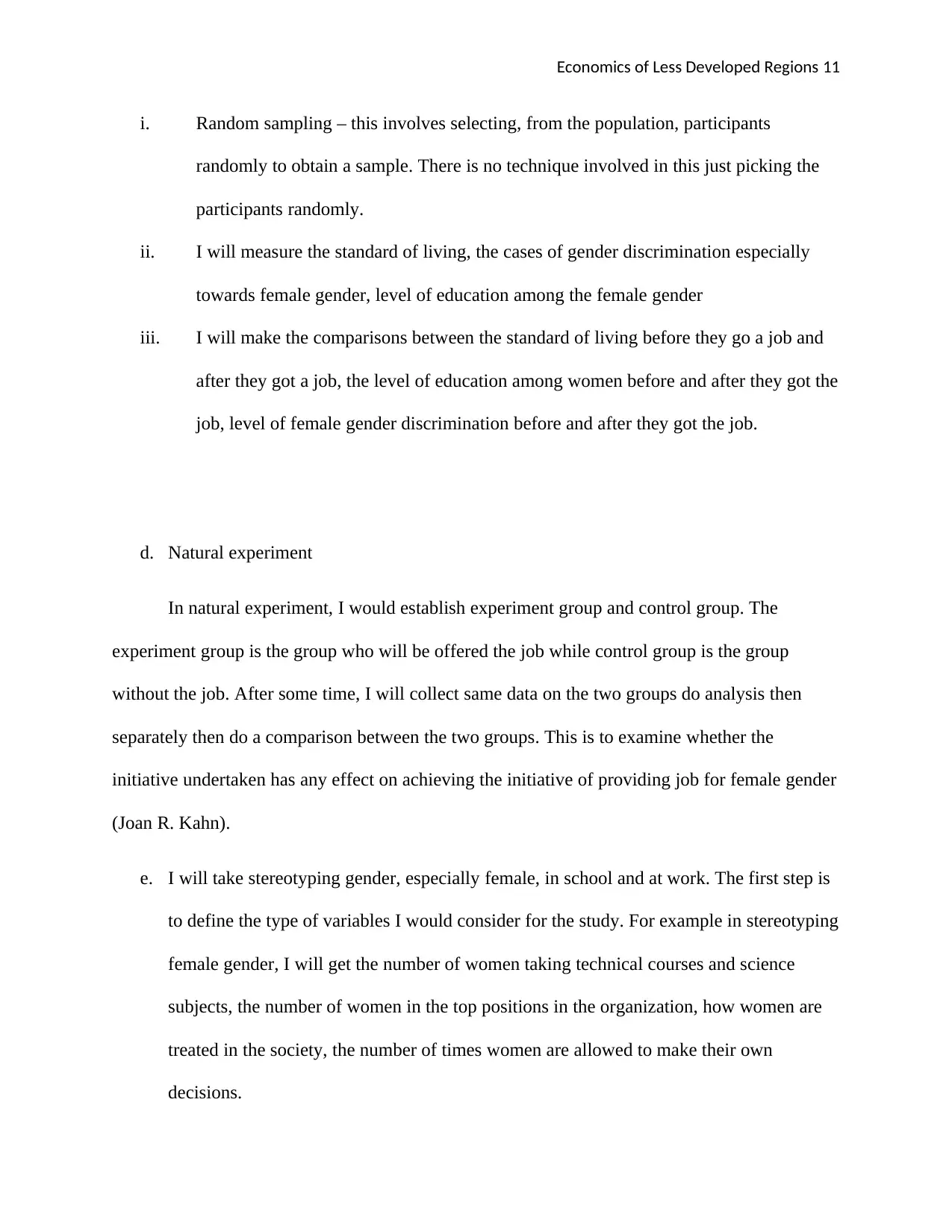
Economics of Less Developed Regions 11
i. Random sampling – this involves selecting, from the population, participants
randomly to obtain a sample. There is no technique involved in this just picking the
participants randomly.
ii. I will measure the standard of living, the cases of gender discrimination especially
towards female gender, level of education among the female gender
iii. I will make the comparisons between the standard of living before they go a job and
after they got a job, the level of education among women before and after they got the
job, level of female gender discrimination before and after they got the job.
d. Natural experiment
In natural experiment, I would establish experiment group and control group. The
experiment group is the group who will be offered the job while control group is the group
without the job. After some time, I will collect same data on the two groups do analysis then
separately then do a comparison between the two groups. This is to examine whether the
initiative undertaken has any effect on achieving the initiative of providing job for female gender
(Joan R. Kahn).
e. I will take stereotyping gender, especially female, in school and at work. The first step is
to define the type of variables I would consider for the study. For example in stereotyping
female gender, I will get the number of women taking technical courses and science
subjects, the number of women in the top positions in the organization, how women are
treated in the society, the number of times women are allowed to make their own
decisions.
i. Random sampling – this involves selecting, from the population, participants
randomly to obtain a sample. There is no technique involved in this just picking the
participants randomly.
ii. I will measure the standard of living, the cases of gender discrimination especially
towards female gender, level of education among the female gender
iii. I will make the comparisons between the standard of living before they go a job and
after they got a job, the level of education among women before and after they got the
job, level of female gender discrimination before and after they got the job.
d. Natural experiment
In natural experiment, I would establish experiment group and control group. The
experiment group is the group who will be offered the job while control group is the group
without the job. After some time, I will collect same data on the two groups do analysis then
separately then do a comparison between the two groups. This is to examine whether the
initiative undertaken has any effect on achieving the initiative of providing job for female gender
(Joan R. Kahn).
e. I will take stereotyping gender, especially female, in school and at work. The first step is
to define the type of variables I would consider for the study. For example in stereotyping
female gender, I will get the number of women taking technical courses and science
subjects, the number of women in the top positions in the organization, how women are
treated in the society, the number of times women are allowed to make their own
decisions.
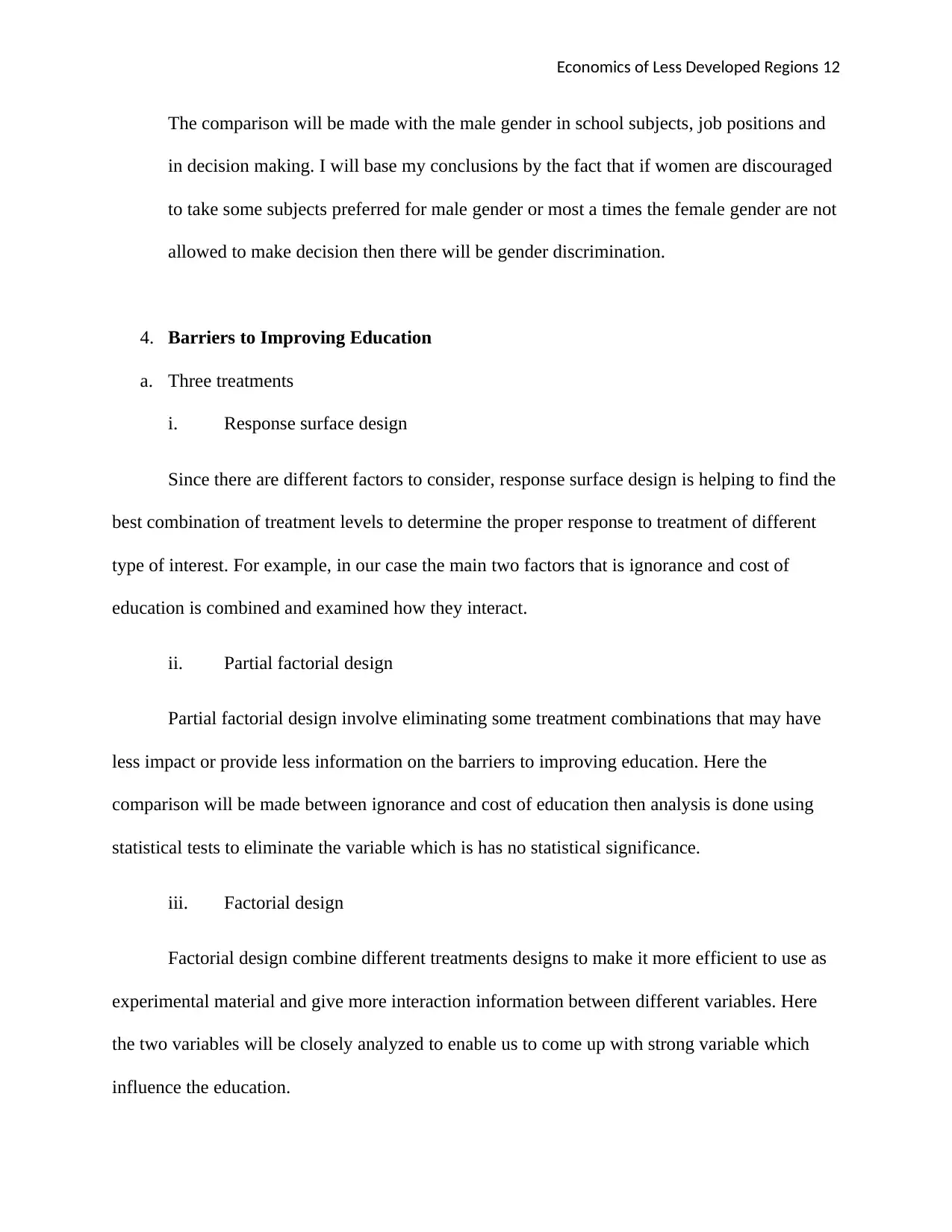
Economics of Less Developed Regions 12
The comparison will be made with the male gender in school subjects, job positions and
in decision making. I will base my conclusions by the fact that if women are discouraged
to take some subjects preferred for male gender or most a times the female gender are not
allowed to make decision then there will be gender discrimination.
4. Barriers to Improving Education
a. Three treatments
i. Response surface design
Since there are different factors to consider, response surface design is helping to find the
best combination of treatment levels to determine the proper response to treatment of different
type of interest. For example, in our case the main two factors that is ignorance and cost of
education is combined and examined how they interact.
ii. Partial factorial design
Partial factorial design involve eliminating some treatment combinations that may have
less impact or provide less information on the barriers to improving education. Here the
comparison will be made between ignorance and cost of education then analysis is done using
statistical tests to eliminate the variable which is has no statistical significance.
iii. Factorial design
Factorial design combine different treatments designs to make it more efficient to use as
experimental material and give more interaction information between different variables. Here
the two variables will be closely analyzed to enable us to come up with strong variable which
influence the education.
The comparison will be made with the male gender in school subjects, job positions and
in decision making. I will base my conclusions by the fact that if women are discouraged
to take some subjects preferred for male gender or most a times the female gender are not
allowed to make decision then there will be gender discrimination.
4. Barriers to Improving Education
a. Three treatments
i. Response surface design
Since there are different factors to consider, response surface design is helping to find the
best combination of treatment levels to determine the proper response to treatment of different
type of interest. For example, in our case the main two factors that is ignorance and cost of
education is combined and examined how they interact.
ii. Partial factorial design
Partial factorial design involve eliminating some treatment combinations that may have
less impact or provide less information on the barriers to improving education. Here the
comparison will be made between ignorance and cost of education then analysis is done using
statistical tests to eliminate the variable which is has no statistical significance.
iii. Factorial design
Factorial design combine different treatments designs to make it more efficient to use as
experimental material and give more interaction information between different variables. Here
the two variables will be closely analyzed to enable us to come up with strong variable which
influence the education.
⊘ This is a preview!⊘
Do you want full access?
Subscribe today to unlock all pages.

Trusted by 1+ million students worldwide
1 out of 15
Your All-in-One AI-Powered Toolkit for Academic Success.
+13062052269
info@desklib.com
Available 24*7 on WhatsApp / Email
![[object Object]](/_next/static/media/star-bottom.7253800d.svg)
Unlock your academic potential
Copyright © 2020–2025 A2Z Services. All Rights Reserved. Developed and managed by ZUCOL.